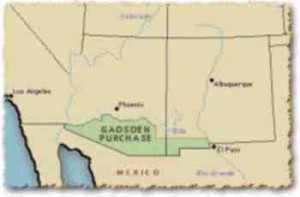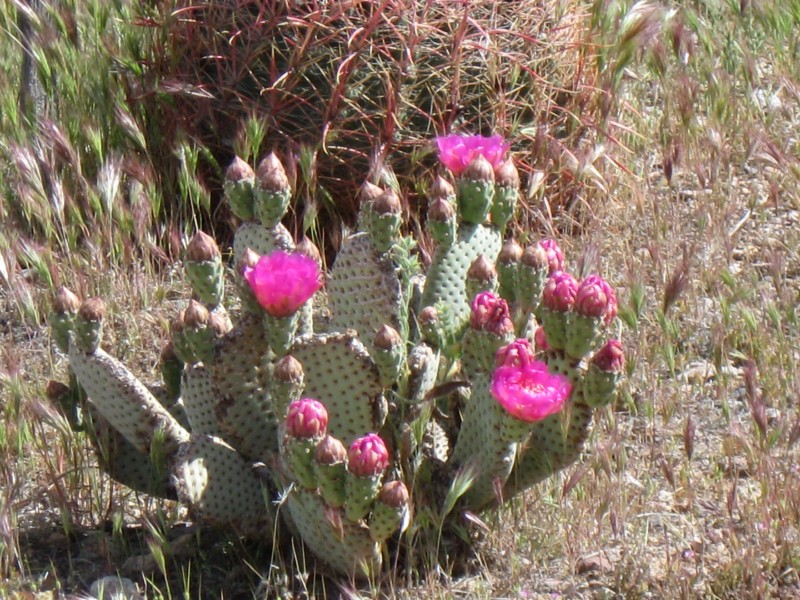 First some background. This is a current map of this portion of the United States, showing where the Gadsden Purchase was and what it consisted of. All the area shown on this map was either a part of the Republic of Texas, or belonged to the Republic of Mexico, prior to 1846. On December 29, 1845 Texas was admitted to the Union as the 28th state. This precipitated a war between Mexico and the United States since the government of Mexico still considered Texas to be a rebellious province.
First some background. This is a current map of this portion of the United States, showing where the Gadsden Purchase was and what it consisted of. All the area shown on this map was either a part of the Republic of Texas, or belonged to the Republic of Mexico, prior to 1846. On December 29, 1845 Texas was admitted to the Union as the 28th state. This precipitated a war between Mexico and the United States since the government of Mexico still considered Texas to be a rebellious province.
The Mexican government established the border between Mexico and Texas as being the Nueces River, giving Mexico more land. The Republic of Texas, though, set the border at the Rio Grande River, giving Texas more land. This disputed border was the proximate cause of the Mexican-American War.
President James K. Polk had dispatched General Zachary Taylor and some 1,500 American troops to secure the border along the Nueces River. Taylor arrived in eastern Texas in July 1845 and was then ordered by President Polk to establish himself, (and his army, of course) in Corpus Christi, Texas – the mouth of the Nueces River, roughly 160 miles north of the Rio Grande. Then, in March of 1846, Taylor was ordered to march to the Rio Grande with his now expanded force of 4,000 troops. He established himself near modern-day Brownsville, Texas, at the mouth of the Rio Grande river. One month later the Mexican army attacked him in an attempt to eject forces they considered to be foreign invaders. Taylor’s forces proved to be too much for the Mexicans, however, and he quickly drove them back beyond the Rio Grande River. President Polk took advantage this relatively minor skirmish and asked Congress for a declaration of war. The United States declared war on Mexico on May 13, 1846, and Mexico reciprocated by declared war on the U.S. on July 7.
The United States invaded Mexico, defeated all her armies and captured all her major cities, including the Capital, Mexico City. The Treaty of Guadalupe Hidalgo, signed on February 2, 1848 by American diplomat Nicholas Trist, ended the war and gave the U.S undisputed control of Texas, established the U.S.-Mexican border of the Rio Grande River and ceded to the United States the territory now occupied by the states of California, Nevada, Utah, and parts of Colorado, Arizona, New Mexico, and Wyoming. In return, Mexico received US$15,000,000. Mexico had lost over 500,000 square miles or 55% of all her territory – more, if you include Texas.
According to the treaty, the boundary between the United States and Mexico was to extend from the Gulf of Mexico and follow the Rio Grande to a point eight miles north of El Paso and then continue west to the first branch of the Gila River. The boundary was established from a map drawn by J. Disturnell of New York. When the United States sent men to survey the boundary, they found that the Disturnell map was in error. El Paso was actually located 40 miles north of its position on the map and the Rio Grande was actually 130 miles to the west.
The United States wanted to make certain “boundary adjustments”; Mexico needed money and wanted a settlement of her Indian claims against the United States. In 1852 the United States, in the person of U.S. Minister to Mexico James Gadsden, agreed to pay Santa Anna $10,000,000 for a strip of territory south of the Gila River and lying in what is now southwestern New Mexico and southern Arizona. What became known as the Gadsden Purchase had an area of 45,535 square miles and was almost as large as Pennsylvania. This tract of nearly 30,000,000 acres cost Uncle Sam about thirty-three cents an acre.
James Gadsden (1788-1858) was not an uninvolved bureaucrat who just happened to be placed into the position of negotiating with Mexico. In his youth he served as a soldier under Andrew Jackson in Florida and afterwards was appointed as a commissioner in charge of placing the Seminole Indians on reservations by President Monroe. He had long been interested in promoting railroads and, upon his return to his native South Carolina in 1839, was chosen president of the South Carolina Railroad Company. His pet dream was to knit all Southern railroads into one system and then to connect it with a Southern transcontinental railroad to the Pacific, to make the West commercially dependent on the South instead of the North.
After engineers advised Gadsden that the most direct and practicable route for the Southern transcontinental railroad would be south of the United States boundary, he made plans to have the Federal Government acquire title to the necessary territory from Mexico. Through his friend and fellow empire dreamer, Secretary of War Jefferson Davis, Gadsden was appointed U.S. Minister to Mexico by President Franklin Pierce with instructions of his own design to buy from Mexico enough territory for a railroad to the Gulf of California. Obviously he succeeded.
some footnotes:
- The Gadsden Purchase was so unpopular in Mexico that Santa Anna (Antonio de Padua María Severino López de Santa Anna y Pérez de Lebrón) was unseated as dictator – again – and banished from Mexico – again.
- Gadsden was recalled as Minister to Mexico for mixing in Mexican politics and domestic affairs and did not live to see the Southern Pacific Railroad built through his purchase.
- And when the inhabitants of Arizona asked Congress for a Territorial government in 1854, one of the names suggested for the new Territory was Gadsonia, a Latin adaptation of the surname of James Gadsden.
- An article in The Progress Report – which appears to be an on-line newsletter, published daily by the Benjamin Banneker Center for Economic Justice and Progress.
- A section of the Viva Mesilla! website – a website devoted to all things Mesilla, New Mexico.
- And Wikipedia, in their section about the Mexican-American War.
